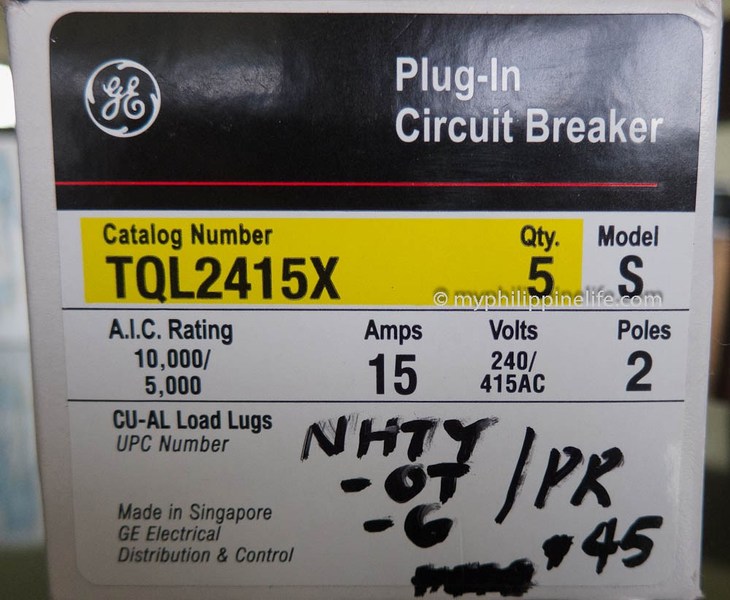The
30A GFCI breakers use
AWG 10 wire to the sockets. The 60A GFCI breakers use AWG 6 to the subpanel. It is the main panel. The electrician and even some engineers didn't suggest 20 space Siemens load center last year as we were not even sure it could work, so settled for the 12 space (6 breakers only). I mean, what if it would nuisance trip on the fridge, air conditioning units, others. Fortunately it has zero nuisance tripping, unlike the GFCI receptacles which can trip on the fridge twice a day for example.
Technically this is a code violation- 15amp sockets can not be on a circuit larger then 20amps.Technically- but if its custom throughout the Philippines it is what it is.
..................
My comment:
Throughout this thread I see numerous references to general use circuit protected by 30 Amp breakers.
This is not a code violation in British standard. . . it is a wiring designed for compatibility with their BS 1363 consumer socket (plug) and their appliance male plugs that have fuses.
It is important to note that the British call “socket” what Americans would call “wall plug” or appliance plug. They use these terms also in Singapore and Malaysia.
Although Australia is close to being British, lol (don't tell this to the separatists

) they don't use the BS 1363 standard. They have their own plug called
crowfoot.
The British use the
ring main style wiring extensively as opposed to the North American
radial style. They also use our
radial system in what they call
“spur circuits” along with their
Main Ring.
For more about British practices look here:
http://main.linuxfocus.org/~guido/javascript/awg.html
It seems like I'm talking foreign because “ring main wiring system” is not mentioned in NEC or any reference to it in electrician's handbook. So I'm quite certain that majority of US master electricians don't even know what I'm talking about.
They do have a good reason not to learn the system. . . why would they ever want to learn them?
While each side of the Atlantic claims that their system is safer than the other. . . each system has its advantage and disadvantage. It is not important to get into the “molecular” level at this time but I will cover a small detail just to provide some perspective on how this
main ring system work and how the comments are related to this British Standard.
I'm not saying that the Philippines use the British System throughout the country, but, as OP had always said, their wiring system is a
hodge-podge of wiring styles depending on where the electrician acquired his skill.
The Philippines is rich in human resources that you will find workers of different trades working in the construction industry—from the Arabian Peninsula to the oil platforms in Lake Maracaibo in Venezuela. I've been there.
I won't be surprised if the electricians that OP were referring to had work in one of the countries like Malaysia, Singapore or Hongkong.
Electricians in these countries were mentored by British engineers.
I was hired by a Chicago-based consulting firm to oversee the construction of a radar station in Southeast Asia years ago (location classified). I saw a lot of “ locals” along with electricians brought in from the mainland US. The first thing I asked the Field Engineer was...if these local workers were trained to work using US standard. I am familiar with MIL-SPECS. . . and I was there to make sure the work was done to conform with MIL-SPECS. This is what I report to my boss.
The Field Engineer's response was, they were hired in Chicago and they came from Chicago. . . well. . . that takes care of that one.

No wonder they all speak English (no offense implored). . . and good English too.

The reason I brought this up is, OP (Tersh) is mingling the two standards (US and UK) that often lead to confusion. Even a seasoned US electrician could be thrown off as indicated by comments that are often tainted with sarcasm fueled by ignorance. They sometimes dismiss newbies' comments as jumbled and fumbling (I can site those comments).
The main ring system branch circuit -- along with other branch circuits in the panelboard-- is distinguishable by being protected by a 30 Amp or 32 Amp fuse or CB. This branch circuit is usually supplied by a 6.0 mm2 conductor which is the equivalent of 10 AWG.
We never use a 30 Amp circuit for convenience outlets for eg. egg-beater or vacuum cleaner. Those 30 amp circuits are common in electric clothes dryers and stoves/ovens or special purpose appliances etc.
It is also common to see 5 Amp fuses and circuit breakers in foreign panelboards.
They are a rarity (if at all) in US panelboards. These 5 Amp for lighting branch circuits are wired with 1.5mm2 conductors which is the equivalent of 14 AWG but a bit smaller.
In-a-nutshell, those comments made by the questioner or responder are not incongruous or irrational-- rather-- their support base differs widely which makes their response rather odd.
I love diversity.















